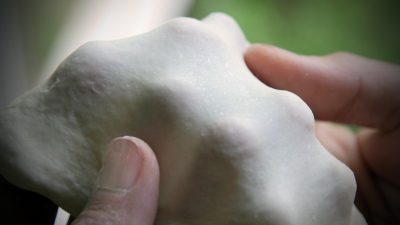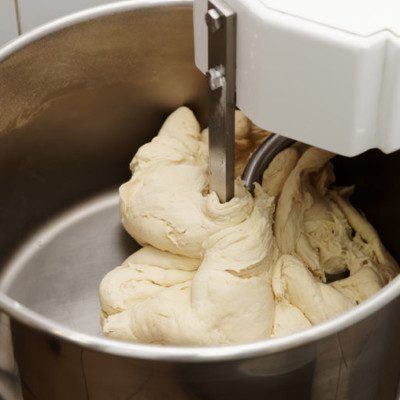Application
When hydrated, gliadin is viscous and can be stretched to a thin strand that flows easily with gravity like glue. On the other hand, hydrated glutenin is very elastic and has a large resistance to deformation and stretching forces. When these two proteins are combined, they form a three-dimensional, continuous network called gluten. So, gluten has both viscous and elastic properties.3
Hydration impacts several functions and properties of gluten proteins:4
- Dispersibility
- Coagulation
- Dough formation
- Gel formation
- Swelling behavior
- Thickening power
- Glass transition
- Water absorption / water-holding capacity
It is impossible to create dough with optimum handling properties without hydrating gluten proteins first. If the dough is not sufficiently hydrated, wheat flour proteins can’t participate in forming a network during baking.
Gluten hydration is influenced by:
- Temperature: the higher the temperature, the faster the hydration process.
- Amount of water: gluten proteins are not the only component of flour that take up water. So, sufficient water is needed to thoroughly hydrate all the gluten present.
- Mixing time: gluten proteins take time to fully hydrate as water gradually diffuses from wet zones to dry zones in the flour.
- Mixing intensity or mechanical work: mixing generates motion in particles. Also, it allows direct contact between flour particles and water.
- Flour particle size: the smaller the flour particle size, the larger the surface area exposed and the faster the hydration of gluten.
- Competition for water absorption: Flour components such as starch, arabinoxylans, β-glucans and cellulose also take up water. As a consequence, they compete with gluten for hydration. If the formula is not well balanced, then gluten will only be partially hydrated.
To see if the dough is properly hydrated and mixed, perform the gluten film or window pane test. A small portion of dough is stretched between the hands into a thin, smooth, translucent film to test its extensibility and elasticity:

Predicting the amount of water for gluten hydration
For example, say there is 100 g flour with a protein content of 13% (gluten accounts for 80%). Gluten needs to absorb about 2 times its own weight to become fully functional (2 g water / 1 g dry gluten).3
The question is, how much of the total water is used to hydrate gluten?
g dry gluten = 100 × 0.13 × 0.8 = 10.4
g water absorbed by gluten = 10.4 × 2 = 20.8
% water = (20.8 ÷ total absorption %) x 100
AACCI Methods used to assess gluten hydration properties
- 56-61.02 – Sedimentation test for wheat
- 56-11.02 – Solvent retention capacity profile (SRC)
- 38-12.02 – Glutomatic (wet/gluten gluten, water-binding capacity and gluten index)
- 56-30.01 – Water hydration capacity of protein materials
References
- Wrigley, C.W., Békés, F., Bushuk, W. “Gluten: A Balance of Gliadin and Glutenin.” Gliadin and Glutenin: The Unique Balance of Wheat Quality, AACC International, Inc., 2006, pp. 3–32.
- Damodaran, S. “Amino Acids, Peptides, and Proteins.” Fennema’s Food Chemistry, 5th Edition, CRC Press, Taylor & Francis Group, LLC, 2017, pp. 235–351.
- Finnie, S., and Atwell, W.A. “Composition of Commercial Flour.” Wheat Flour, 2nd Edition, AACC International, Inc., 2016, pp. 31–42.
- Li-Chan, E.C.Y., and Lacroix, I.M.E. “Properties of Proteins in Food Systems: An Introduction.” Proteins in Food Processing, 2nd Edition, Woodhead Publishing, Elsevier Inc., 2018, pp. 19–45.

